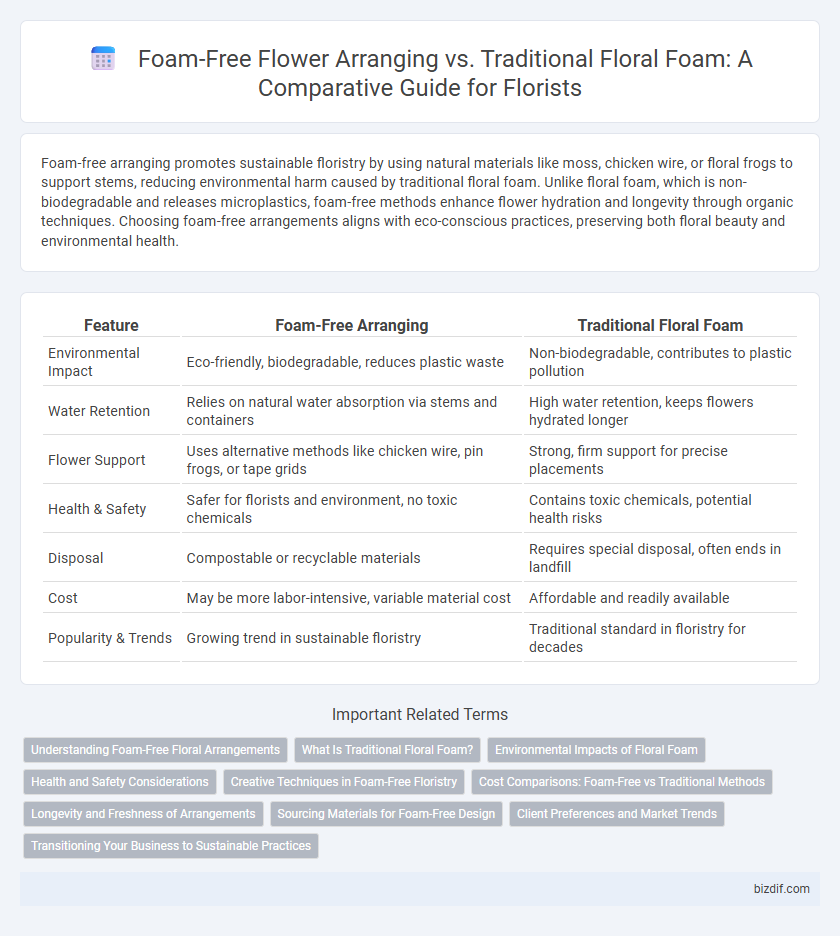Foam-free arranging promotes sustainable floristry by using natural materials like moss, chicken wire, or floral frogs to support stems, reducing environmental harm caused by traditional floral foam. Unlike floral foam, which is non-biodegradable and releases microplastics, foam-free methods enhance flower hydration and longevity through organic techniques. Choosing foam-free arrangements aligns with eco-conscious practices, preserving both floral beauty and environmental health.
Table of Comparison
| Feature | Foam-Free Arranging | Traditional Floral Foam |
|---|---|---|
| Environmental Impact | Eco-friendly, biodegradable, reduces plastic waste | Non-biodegradable, contributes to plastic pollution |
| Water Retention | Relies on natural water absorption via stems and containers | High water retention, keeps flowers hydrated longer |
| Flower Support | Uses alternative methods like chicken wire, pin frogs, or tape grids | Strong, firm support for precise placements |
| Health & Safety | Safer for florists and environment, no toxic chemicals | Contains toxic chemicals, potential health risks |
| Disposal | Compostable or recyclable materials | Requires special disposal, often ends in landfill |
| Cost | May be more labor-intensive, variable material cost | Affordable and readily available |
| Popularity & Trends | Growing trend in sustainable floristry | Traditional standard in floristry for decades |
Understanding Foam-Free Floral Arrangements
Foam-free floral arrangements emphasize sustainability by eliminating traditional floral foam, which is non-biodegradable and environmentally harmful. Techniques such as using natural materials like moss, chicken wire, or floral frogs provide structure and hydration while supporting eco-friendly practices. This approach encourages creativity and longevity in floristry by promoting the use of fresh flowers with minimal waste and increased biodegradability.
What Is Traditional Floral Foam?
Traditional floral foam is a water-absorbent material used extensively in floristry to secure stems and prolong flower freshness by providing consistent hydration. Composed of phenolic foam, it was invented in the 1950s and remains popular for its ease of shaping and ability to hold arrangements firmly in place. Despite its convenience, traditional floral foam poses environmental concerns due to its non-biodegradable nature and chemical composition.
Environmental Impacts of Floral Foam
Traditional floral foam, composed of non-biodegradable plastic polymers, poses significant environmental hazards due to its persistence in landfills and contribution to microplastic pollution. Foam-free arranging utilizes sustainable alternatives such as reusable floral frogs, chicken wire, or natural moss, drastically reducing waste and promoting eco-friendly floral design practices. Shifting to foam-free methods aligns with growing industry demands for environmentally responsible floristry that minimizes plastic contamination and supports biodiversity.
Health and Safety Considerations
Foam-free arranging eliminates the exposure to harmful chemicals found in traditional floral foam, such as phenol and formaldehyde, which are known carcinogens and respiratory irritants. Choosing sustainable alternatives reduces environmental pollution and promotes indoor air quality, safeguarding both florists and clients from potential health risks. Adopting health-conscious practices enhances workplace safety by minimizing allergic reactions and skin irritations common with foam handling.
Creative Techniques in Foam-Free Floristry
Foam-free floristry emphasizes sustainable, environmentally friendly methods that use natural mechanics like floral frogs, chicken wire, and curvilinear stems to create structured designs without synthetic foam. Creative techniques include wiring, taping, and soaking stems in water before arranging to maintain hydration and shape stability. This approach encourages innovation with floral materials, enhancing texture, movement, and organic form in arrangements.
Cost Comparisons: Foam-Free vs Traditional Methods
Foam-free floral arranging reduces ongoing expenses by eliminating the need for disposable floral foam blocks, which typically cost around $2 to $5 each and are single-use. Traditional floral foam can increase both material costs and waste disposal fees, while foam-free methods utilize reusable mechanics like chicken wire, costing under $1 per arrangement over time. Choosing foam-free techniques promotes environmentally sustainable practices without significantly raising overall floral arrangement costs, making it a cost-effective alternative for professional florists.
Longevity and Freshness of Arrangements
Foam-free arranging enhances the longevity and freshness of floral designs by allowing natural water flow to stems, reducing the risk of bacterial growth compared to traditional floral foam. Traditional floral foam often traps water, which can become a breeding ground for bacteria, accelerating flower decay. Choosing sustainable techniques not only supports environmental health but also ensures that arrangements maintain their vibrancy for an extended period.
Sourcing Materials for Foam-Free Design
Sourcing materials for foam-free floral arranging emphasizes sustainable, biodegradable options such as moss, chicken wire, and natural plant bases like succulents or dried branches. These alternatives reduce environmental impact by eliminating non-biodegradable floral foams, promoting eco-friendly floristry practices. Florists often prioritize locally sourced, renewable materials to enhance freshness and support sustainable supply chains while maintaining creative design flexibility.
Client Preferences and Market Trends
Growing client demand for sustainable floristry fuels the shift from traditional floral foam to foam-free arranging methods, emphasizing eco-friendly materials like moss, chicken wire, and reusable floral frogs. Market trends reveal a rise in artisan florists prioritizing biodegradable options that preserve flower freshness without harmful chemical residues. Consumer preference increasingly aligns with environmental responsibility, prompting florists to innovate green design techniques that maintain aesthetic quality while reducing ecological impact.
Transitioning Your Business to Sustainable Practices
Transitioning to foam-free arranging reduces environmental impact by eliminating non-biodegradable floral foam, which contains harmful chemicals. Embracing sustainable practices such as using reusable or natural materials like moss, chicken wire, or biodegradable floral foam alternatives enhances eco-friendly floral design. This shift not only supports environmental responsibility but also aligns with the growing consumer demand for green products in the floristry market.
Foam-Free Arranging vs Traditional Floral Foam Infographic

 bizdif.com
bizdif.com